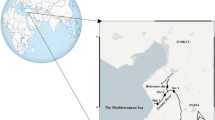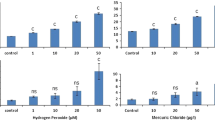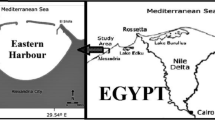Abstract
There are rising concerns about the hazardous effects of heavy metals on the environment. In this study, comet assay and DNA alkaline unwinding assay were conducted on the tissues (gills, hepatopancreas, and hemocytes) of Charybdis japonica in order to illustrate genotoxicity of three heavy metal ions (Cu2+, Pb2+, and Cd2+) on the marine crabs C. japonica. The crabs were exposed to Cu2+ (10, 50, and 100 μg.L−1), Pb2+ (50, 250, and 500 μg L−1) and Cd2+ (5, 25, and 50 μg L−1), and the tissues were sampled at days 0.5, 1, 3, 6, 9, and 15. DNA alkaline unwinding assay was used for testing the DNA single strand break in gills and hepatopancreas and comet assay was employed for testing the DNA damage in hemocytes. The results showed that the DNA damage (F-value) of gills in the crabs exposed to the three heavy metals was decreased gradually during the exposure periods and there was a dose-time response relationship in certain time, suggesting that the levels of DNA single strand break in all the experimental groups increased significantly compared to the controls. Changes of F-value in hepatopancreas of the crabs exposed to the three heavy metals were similar to those in gills except that the peak values were found in the 500 μg L−1 Pb2+ treatment group at day 3 and the 50 μg L−1 Cd2+ treatment group at day 9. The ranks of DNA damage in gills and hepatopancreas induced by the three heavy metal ions (50 μg L−1, day 15) were Cd2+ >Pb2+ >Cu2+ and Pb2+ >Cu2+ >Cd2+. The levels of DNA damage in gills were higher than those in hepatopancreas in the same experimental group. It can be concluded that indices of DNA damage can be used as the potential biomarkers of heavy metal pollution in marine environment.
Similar content being viewed by others
References
Almeida, J. A., Diniz, Y. S., Marques, S. F. G., Faine, L. A., Ribas, B. O., Burneiko, R. C., and Novelli, E. L. B., 2002. The use of the oxidative stress responses as biomarkers in Nile tilapia (Oreochromis niloticus) exposed to in vivo cadmium contamination. Environment International, 27: 673–679.
Black, M. C., Ferrell, J. R., Horning, R. C., and Martin, L. K. Jr., 1996. DNA strand breakage in freshwater mussels (Anodonta grandis) exposed to lead in the laboratory and field. Environmental Toxicology and Chemistry, 15: 802–808.
Bu-Olayan, A. H., and Subrahmanyam, M. N. V., 1998. Trace metal concentrations in the crab Macrophthalmus depressus and sediments on the Kuwait coast. Environmental Monitoring and Assessment, 53(2): 297–304.
Cesarone, C. F., Bologenesi, C., and Santi, L., 1979. Improved microfluorometric DNA determination in biological material using 33258 Hoechst. Analytical Biochemistry, 100 (1): 188–197.
Chandra, P., and Khuda-Bukhsh, A. R., 2001. An assay of genotoxicity produced by cadmium chloride in fish (Oreochromis mossambicus) and efficacy of vitamin C in its alterations. In: Perspectives in Cytology and Genetics. Manna, G. K., and Roy, S. C., eds., AICCG Publications, Kalyani, India, 583–590.
Ching, E. W. K, Siu, W. H. L., Lam, P. K. S., Xu, L., Zhang, Y. Y., and Richardson, B. J., 2001. DNA adduct formation and DNA strand breaks in green-lipped mussels (Perna viridis) exposed to benzo[a]pyrene: dose- and time-dependent relationships. Marine Pollution Bulletin, 42: 603–610.
Cohen, M. D., Bowser, D. H., and Costa, M., 1996. Carcinogenicity and genotoxicity of lead, beryllium and other metals. In: Toxicology of Metals. Chang, L. W., Magos, L., and Suzuki, T., eds., Lewis Publishers, CRC Press Inc., Boca Raton, Florida, USA, 253–284.
Collins, A. R., Ma, A. G., and Duthie, S. J., 1995. The kinetics of repair of oxidative DNA damage (strand breaks and oxidized pyrimidines) in human cells. Mutation Research/DNA Repair, 336: 69–77.
Ercal, N., Gurer-Orhan, H., and Aykin-Burns, N., 2001. Toxic metals and oxidative stress part I: mechanisms involved in metal-induced oxidative damage. Current Topics Medicinal Chemistry, 1: 529–539.
Everaarts, J. M., and Sarkar, A., 1996. DNA damage as a biomarker of marine pollution: strand breaks in seastars (Asterias rubens) from the north sea. Water Science and Technology, 34: 157–162.
Gibson, R., and Barker, P. L., 1979. The decapoda hepatopancreas. Oceanography and Marine Biology Annual Review, 17: 285–346.
Hartwig, A., 1994. Role of DNA repair inhibition in lead- and cadmium-induced genotoxicity: a review. Environmental Health Perspectives, 102: 45–50.
Hickey, R. F., Vanderwielen, J., and Switzenbaum, M. S., 1989. The effect of heavy metals on methane production and hydrogen and carbon monoxide levels during batch anaerobic sludge digestion. Water Research, 23: 207–218.
Hook, S. E., and Lee, R. F., 2004. Interactive effects of UV, benzo[α] pyrene, and cadmium on DNA damage and repair in embryos of the grass shrimp Palaemonetes pugio. Marine Environmental Research, 58: 735–739.
Khan, T. H., Jahangir, T., Prasad, L., and Sultana, S., 2006. Inhibitory effect of apigenin on benzo(a)pyrene-mediated genotoxicity in Swiss albino mice. Journal of Pharmacy and Pharmacology, 58 (12): 1 655–1 660.
Kong, I. C., Bitton, G., Koopman B., and Jung, K. H., 1995. Heavy metal toxicity testing in environmental samples. Reviews of Environmental Contamination and Toxicology, 142: 119–147.
Kurelec, B., 1993. The genotoxic disease syndrome. Marine Environmental Research, 35: 341–348.
Liu, N., Yan, B., Li, Y. Q., Wang, Q., and Wang, L., 2008. Effects of Cd2+ on glutathione system of hepatopancreas and gills in freshwater crab Sinopotamon yangtsekiense. Environmental Science, 29(8): 2302–2307 (in Chinese with English abstract).
Mihaljević, Z., Ternjej, I., Stanković, I., Kerovec, M., and Kopjar, N., 2009. Application of the comet assay and detection of DNA damage in hemocytes of medicinal leech affected by aluminium pollution: A case study. Environmental Pollution, 157: 1 565–1 572.
Misra, R. R., Smith, G. T., and Waalkes, M. P., 1998. Evaluation of the direct genotoxin potential of cadmium in four different rodent cell lines. Toxicology, 126: 103–114.
Mourón, S. A., Golijow, C. D., and Dulout, F. N., 2001. DNA damage by cadmium and arsenic salts assessed by the single cell gel electrophresis assay. Mutation Research, 498: 47–55.
Müller, W. E. G., Batel, R., Lacorn, M., Steinhart, H., Simat, T., Lauenroth, S., Hassanein, H., and Schröder, H. C., 1998. Accumulation of cadmium and zinc in the marine sponge Suberites domuncula and its potential consequences on single-strand breaks and on expression of heat-shock protein: a natural filed study. Marine Ecology Progress Series, 167: 127–135.
Nriagu, J. O., and Pacyna, J. M., 1988. Quantitative assessment of worldwide contamination of air, water and soils by trace metals. Nature, 333: 134–139.
Olive, P. L., 1999. DNA damage and repair in inidividual cells: applications of the comet assay in radiobiology. International Journal of Radiation Biology, 75: 395–405.
Pan, L. Q., and Zhang, H. X., 2006. Metallothionein, antioxidant enzymes and DNA strand breaks as biomarkers of Cd exposure in a marine crab, Charybdis japonica. Comparative Biochemistry and Physiology, Part C: Toxicology and Pharmacology, 144: 67–75.
Pisoni, M., Cogotzi, L., Frigeri, A., Corsi, I., Bonacci, S., Iacocca, A., Lancini, L., Mastrotoraro, F., Focardi, S., and Svelto, M., 2004. DNA adducts, benzo(a)pyrene monooxy genase activity, and lysosomal membrane stability in Mytilus galloprovincialis from different areas in Taranto coastal waters (Italy). Environmental Research, 96: 163–175.
Pruski, A. M., and Dixon, D. R., 2002. Effects of cadmium on nuclear integrity and DNA repair efficiency in the gill cells of Mytilus edulis L. Aquatic Toxicology, 57: 127–137.
Regoli, F., and Orlando, E., 1994. Accumulation and subcellular distribution of metals (Cu, Fe, Mn, Pb and Zn) in the Mediterranean mussel Mylilus galloprovincialis during a field transplant experiment. Marine Pollution Bulletin, 28: 592–600.
Sanchez-Galan, S., Linde, A. R., and Garcia-Vazquez, E., 1999. Brown trout and European minnow as target species for genotoxicity tests: differential sensitivity to heavy metals. Ecotoxicology and Environmental Safety, 43: 301–304.
Shugart, L. R., 1988a. Quantitation of chemically induced damage to DNA of aquatic organisms by alkaline unwinding assay. Aquatic Toxicology, 13: 43–52.
Shugart, L. R., 1988b. An alkaline unwinding assay for the detection of DNA damage in aquatic organisms. Marine Environmental Research, 24: 321–325.
Shugart, L. R., 2000. DNA damage as a biomarker of exposure. Ecotoxicology, 9: 329–340.
Singh, N. P., McCoy, M. T., Tice, R. R., and Schneider, E. L., 1988. A simple technique for quantitation of low levels of DNA damage in individual cells. Experimental Cell Research, 175: 184–191.
Siu, W. H. L., Hung, C. L. H., Wong, H. L., Richardson, B. J., and Lam, P. K. S., 2003. Exposure and time dependent DNA strand breakage in hepatopancreas of green-lipped mussels (Perna viridis) exposed to Aroclor 1254, and mixtures of B[a]P and Aroclor 1254. Marine Pollution Bulletin, 46: 1285–1293.
Steinert, S. A., 1996. Contribution of apoptosis to observed DNA damage in mussel cells. Marine Environmental Research, 42: 253–259.
Stohs, S. J., Bagchi, D., Hassoun, E., and Bagchi, M., 2001. Oxidative mechanisms in the toxicity of chromium and cadmium ions. Journal of Environmenatl Pathology, Toxicology and Oncology, 20: 77–88.
Tsuzuki, K., Sugiyama, M., and Haramaki, N., 1994. DNA single-strand breaks and cytotoxicity induced by chromate (VI), cadmium (II) and mercury (II) in hydrogen peroxide-resistant cell lines. Environmental Health Perspectives, 102: 341–342.
Valko, M., Rhodes, C. J., Moncol, J., Izakovic, M., and Mazur, M., 2006. Free radicals, metals and antioxidants in oxidative stress-induced cancer. Chemico-Biological Interactions, 160: 1–40.
Viarengo, A., Canesi, L., Pertica, M., Poli, G., Moore, M. N., and Orunesu, M., 1990. Heavy metal effects on lipid peroxidation in the tissues of Mytilus gallopro vincialis Lam. Comparative Biochemistry and Physiology, Part C: Comparative Pharmacology, 97: 37–42.
Verlecar, X. N., Jena, K. B., and Chainy, G. B. N., 2008. Modulation of antioxidant defences in digestive gland of Perna viridis (L.), on mercury exposures. Chemosphere, 71: 1977–1985.
Zhou, X. W., Zhu, G. N., Sun, J. H., and Mwalilino, J., 2002. The liver cellur DNA breaks and repair of the fish (Carassius auratus) induced by the sublethal metal mixture. Nuclear Techniques, 25: 408–412 (in Chinese with English abstract).
Author information
Authors and Affiliations
Corresponding author
Rights and permissions
About this article
Cite this article
Pan, L., Liu, N., Zhang, H. et al. Effects of heavy metal ions (Cu2+, Pb2+ and Cd2+) on DNA damage of the gills, hemocytes and hepatopancreas of marine crab, Charybdis japonica . J. Ocean Univ. China 10, 177–184 (2011). https://doi.org/10.1007/s11802-011-1809-2
Received:
Revised:
Accepted:
Published:
Issue Date:
DOI: https://doi.org/10.1007/s11802-011-1809-2




